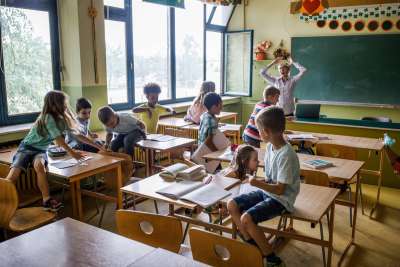Creating a Physical Learning Environment
Expert Opinion
When designing your classroom, remember that furniture directs the flow of traffic within the classroom environment and defines the instructional activities that can take place within that classroom.
If you've ever been in a classroom in which all the desks were in straight rows and straight lines, you might have gotten the impression that it was an orderly classroom run by an orderly teacher and a place not subject to change, modification, or variation. Such classrooms can be sterile and predictable—and not much fun!
Arranging the furniture may be the most important thing you can do before students arrive on that all-important first day. Use a piece of graph paper and draw your current classroom arrangement, including all the tables, desks, windows, doors, bookcases, cabinets, electrical outlets, bulletin boards, and even the wastepaper basket and pencil sharpener. I like to cut out small pieces of paper in the shape and scaled dimensions of all these items so I can move them around on the graph paper. Use this model to make decisions on the preferred placement of furniture in your room.
The arrangement of furniture in a classroom is an important decision to make before students arrive on the first day. However, you should feel comfortable changing the arrangement several times throughout the year. Modifying and adjusting the configuration of students' desks (and yours) is just as natural as changing the location of the sofa, love seat, TV, coffee table, and lamps in your living room at home.
Let's look at some possible room arrangements:
Expert Opinion
After you arrange the furniture in your classroom, take time to sit at each student's desk. Determine if you have a clear line of sight to the chalkboard. Is the chalkboard easy to read?
Horseshoe configuration. One of the most versatile designs for any classroom is the horseshoe pattern. You can set up two or three large semicircles of student desks facing the chalkboard or front of the room. Or scatter mini-horseshoe patterns of a few desks each about the classroom. This pattern opens up the center front of the room for oral presentations, skits, or small group work on the floor.
A variation of the horseshoe pattern is the "U" or three-sided arrangement of desks. Two or three desks form each of the two sides, and two or three desks form the bottom of the pattern.
Clusters. Another popular way of arranging student desks is in clusters or small groupings of four or five student desks together. In a classroom of 25 students, you might have 5 clusters of 5 desks each. Separate each cluster with sufficient space for student movement. Clusters enhance social interactions among students and provide for easy access by the teacher.
Pairs or triads. A variation on the cluster approach is the arrangement of student desks into small groups of two or three. Students create mini-groups of study buddies and can work together for extended periods of time on selected projects and activities.
Rows and lines. You might want to consider rows or lines as an initial arrangement at the beginning of the year. By assigning students to specific desks, you can learn their names and get a sense of the different personalities and instructional needs quicker. Later, you can arrange the classroom in other configurations based on the needs and abilities of students.
Combination approach. You might want to use a combination of several arrangements. A combination approach allows you several instructional options and signals to students that both you and your classroom are flexible. You might invite students to suggest a variety of flexible options according to planned units of study or personal preferences. By allowing students to make some choices in the physical design of the classroom, you're providing them with an important sense of ownership in the classroom.
The most important consideration in any arrangement of desks and other furniture in your classroom is that students must always have a clear and unobstructed view of all instruction. Whether you lecture, show a video, conduct a scientific experiment, invite a guest speaker, or use the chalkboard, it's important that every student, no matter their physical placement, be able to see and hear what is going on.














